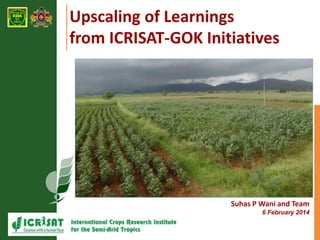
Improving Rainfed Agriculture in Karnataka Through Resilience and Inclusiveness
- 1. Upscaling of Learnings from ICRISAT-GOK Initiatives Suhas P Wani and Team 6 February 2014
- 2. Journey thru ICRISAT-GOK Initiatives 2003 2009 2012 Sujala-ICRISAT Bhoochetana Bhoochetana Plus 2013 Bhoochetana II 2014 Rainfed Agric. Policy 0.25 Million hectares 3.73 Million hectares 7.0 Million hectares 3700 hectares
- 3. Sujala-ICRISAT Initiative Main Message Productivity of crops in the nucleus and satellite watersheds is increased by upto 345% with best-bet options for ragi (230%), groundnut (240%), sunflower (345%), maize (150%) and soybean (116%) resulting in increased incomes
- 4. Bhoochetana-ICRISAT Initiative Main Message Science-led approach promoted by Government of Karnataka adopted by farmers increased crop yields by 32 to 64 per cent over the normal farmer’s practice Rain-fed Agriculture development could become growth engine for reducing poverty and achieving food security in Karnataka and India
- 5. Planetary Boundaries: Safe Operating Space for Humanity Biodiversity loss, Nitrogen cycle and climate change are various parameters has reached beyond its permissible threshold at planetary scale Nature, 2009
- 6. Resilient Agriculture Investigators Network (RAIN)4Sustainable Development in Karnataka
- 7. Torch Bearers for Resilient Agriculture Establishment of Resilient Agriculture Investigator Network (RAIN) Developing a common understanding about resilient agriculture Developing a common approach, instruments, methodology, data set and terminology for resilient agriculture Establish the sites of Resilience Learning Sensitize all the stakeholders to use the resilience and vulnerability lense
- 8. Bhoochetana: Increasing Adoption, Area Coverage and Impact: A Challenge to Meet
- 9. Why We Need to Take a Challenge Increased vulnerability of rainfed agriculture due to climate change Food security is at risk Sustainable development is in question
- 10. Bhoochetana Potential Sustainable Development Approach Science-led Participatory R4D 4 I C Es Innovate Collective Efficiency Inclusive Cooperation Equity Integrated Capacity building Environment Protection Intensification Consortium Economic gain
- 11. Achievements Increased crop yield by 2066% Rise in agriculture growth annually above 5% since 2009 Benefit cost ratio for the farmers 3-14:1 Net benefits accrued in 4 years Rs. 1268 Crores
- 12. Improved Agricultural Practices Increased Crop Yields and Incomes in Karnataka: Bhoochetana 6 5 4 3 2 1 0 2009 2010 2011 2012 Crop yield (ton/ha) 600 500 400 300 200 100 0 Area under improved management (1000 ha) Farmers practice (ton/ha) Improved practice (tons/ha) Area under improved mgt (ha) Year 2009 2010 2011 2012 Total Net income (Rs in Crores) 11.49 204.81 599.45 451.80 1267.60 Net income (Million US$) 2.52 45.72 112.48 82.44 243.16 Example: Bhoochetana
- 13. Increased Mean Crop Yields in the State during Rainy Season 2013
- 14. Distribution of Micronutrients in Total (tons) and Per Hectare (kg) under Bhoochetana Project Year consumed Season Area covered (Lakhs ha) Quantity Consumed (t) Nutrient used (kg ha-1) ZnSO4 Gypsum Borax ZnSO4 Gypsum Borax 2009 Kharif 2.25 372 4309 53 1.65 19.15 0.23 Rabi 0.59 - - - - - - 2010 Kharif 12.72 2723 35376 389 2.27 29.50 0.32 Rabi 3.70 362 5595 113 1.09 16.86 0.34 2011 Kharif 28.44 8775 96234 2781 3.46 37.90 1.10 Rabi 6.60 1678 12475 432 2.94 21.87 0.76 2012 Kharif 35.70 6803 59935 3104 2.25 21.5 0.77
- 15. Nutrient Consumption-based High and Low Performing Districts under Bhoochetana during 2009 to 2013
- 16. Number of Farmers Participated and Area Covered in Bhoochetana in Karnataka *Figures in parentheses indicate No. of farmers (million) participated
- 17. Changes in the Soil Nutrient Deficiencies in Four District under Bhoochetana in Karnataka during 2008 and 2012
- 18. Soil Nutrient Status in Fields under Bhoochetana in Karnataka during 2008 and 2012 *Facts are based on analysis of four sample districts viz. Chitradurga, Haveri, Kolar and Dharwad ** Units for OC is % ; for P, K, S, Zn, B are mg kg-1 soil ; and for EC is dS m-1
- 19. Revolutionising Rain-fed Agriculture thru Inclusivity and Resilience (ReRAInRe) in Karnataka
- 20. Specific Objectives The specific objectives are: To revolutionise the rain-fed agriculture in the state through science-led inclusive development through integrated management of farms for increasing productivity and profits by 50 per cent in five years by enabling farmers to adopt holistic “Seed to Plate” approach; To enhance resilience of the rain-fed farmers as well as farming systems through suitable adaptation and mitigation interventions for the anticipated impacts of climate variability and change; To develop effective and sustainable integrated knowledge and inputs delivery systems for the farmers through public private partnerships; To undertake sustainable intensification and diversification of farming systems through mechanisation for sustainable development and harnessing the market potential for the small farmers for enhancing their incomes; To build the capacity of different stakeholders such as DoA officials, private entrepreneurs, development workers including non-government organisations (NGOs), farmers and policy makers in the state.
- 21. Five Pillars for Sustainable Development Integrated soil, water, nutrient and crop management options (holistic approach) as an entry point to harness low hanging fruits Farmers-centric sustainable delivery systems thru public-private partnerships (PPP) for empowerment of farmers
- 22. Five Pillars for Sustainable Development (Contd..) Effective and sustainable seed delivery systems for Improved crops and cultivars for transforming subsistence agriculture into business model to diversify and intensify agriculture Social mobilisation for mechanisation thru collective action and minimum tillage Inclusive Market Oriented Development (IMOD) thru ensuring credit and institutional support to build resilience and enhance profits
- 23. Thank you!
